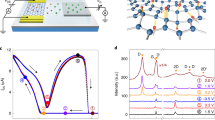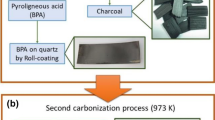Abstract
With its exceptional charge mobility, graphene holds great promise for applications in next-generation electronics. In an effort to tailor its properties and interfacial characteristics, the chemical functionalization of graphene is being actively pursued. The oxidation of graphene via the Hummers method is most widely used in current studies, although the chemical inhomogeneity and irreversibility of the resulting graphene oxide compromises its use in high-performance devices. Here, we present an alternative approach for oxidizing epitaxial graphene using atomic oxygen in ultrahigh vacuum. Atomic-resolution characterization with scanning tunnelling microscopy is quantitatively compared to density functional theory, showing that ultrahigh-vacuum oxidization results in uniform epoxy functionalization. Furthermore, this oxidation is shown to be fully reversible at temperatures as low as 260 °C using scanning tunnelling microscopy and spectroscopic techniques. In this manner, ultrahigh-vacuum oxidation overcomes the limitations of Hummers-method graphene oxide, thus creating new opportunities for the study and application of chemically functionalized graphene.
This is a preview of subscription content, access via your institution
Access options
Subscribe to this journal
Receive 12 print issues and online access
$259.00 per year
only $21.58 per issue
Buy this article
- Purchase on Springer Link
- Instant access to full article PDF
Prices may be subject to local taxes which are calculated during checkout




Similar content being viewed by others
References
Morozov, S. V. et al. Giant intrinsic carrier mobilities in graphene and its bilayer. Phys. Rev. Lett. 100, 016602 (2008).
Lee, C., Wei, X., Kysar, J. W. & Hone, J. Measurement of the elastic properties and intrinsic strength of monolayer graphene. Science 321, 385–388 (2008).
Lin, Y. -M. et al. Wafer-scale graphene integrated circuit. Science 332, 1294–1297 (2011).
Chiang, C. K. et al. Synthesis of highly conducting films of derivatives of polyacetylene. J. Am. Chem. Soc. 100, 1013–1015 (1978).
Elias, D. C. et al. Control of graphene's properties by reversible hydrogenation: evidence for graphane. Science 323, 610–613 (2009).
Robinson, J. T. et al. Properties of fluorinated graphene films. Nano Lett. 10, 3001–3005 (2010).
Nair, R. R. et al. Fluorographene: a two-dimensional counterpart of Teflon. Small 6, 2877–2884 (2010).
Niyogi, S. et al. Spectroscopy of covalently functionalized graphene. Nano Lett. 10, 4061–4066 (2010).
Hossain, M. Z., Walsh, M. A. & Hersam, M. C. Scanning tunneling microscopy, spectroscopy, and nanolithography of epitaxial graphene chemically modified with aryl moieties. J. Am. Chem. Soc. 132, 15399–15403 (2010).
Chen, W., Chen, S., Qi, D. C., Gao, X. Y. & Wee, A. T .S. Surface transfer p-type doping of epitaxial graphene. J. Am. Chem. Soc. 129, 10418–10422 (2007).
Wang, X., Tabakman, S. M. & Dai, H. Atomic layer deposition of metal oxides on pristine and functionalized graphene. J. Am. Chem. Soc. 130, 8152–8153 (2008).
Wang, Q. H. & Hersam, M. C. Room-temperature molecular-resolution characterization of self-assembled organic monolayers on epitaxial graphene. Nature Chem. 1, 206–211 (2009).
Brodie, B. C. On the atomic weight of graphite. Phil. Trans. R. Soc. 149, 249–259 (1859).
Park, S. & Ruoff, R. S. Chemical methods for the production of graphenes. Nature Nanotech. 4, 317–224 (2009).
Hummers, W. S. & Offeman, R. E. Preparation of graphitic oxide. J. Am. Chem. Soc. 80, 1339 (1958).
Dreyer, D. R., Park, S., Bielawski, C. W. & Ruoff, R. S. The chemistry of graphene oxide. Chem. Soc. Rev. 39, 228–240 (2010).
Stankovich, S. et al. Synthesis of graphene-based nanosheets via chemical reduction of exfoliated graphene oxide. Carbon 45, 1558–1565 (2007).
Becerril, H. A., Mao, J., Liu, Z., Stoltenberg, R. M., Bao, Z. & Chen, Y. Evaluation of solution-processed reduced graphene oxide films as transparent conductors. ACS Nano 2, 463–470 (2008).
Gomez-Navarro, C. et al. Atomic structure of reduced graphene oxide. Nano Lett. 10, 1144–1148 (2010).
Bagri, A. et al. Structural evolution during the reduction of chemically derived graphene oxide. Nature Chem. 2, 581–587 (2010).
Dikin, D. A. et al. Preparation and characterization of graphene oxide paper. Nature 448, 457–460 (2007).
Park, S. et al. Biocompatible, robust free-standing paper composed of a TWEEN/graphene composite. Adv. Mater. 22, 1736–1740 (2010).
Ferralis, N., Maboudian, R. & Carraro, C. Evidence of structural strain in epitaxial graphene layers on 6H-SiC(0001). Phys. Rev. Lett. 101, 156801 (2008).
Röhrl, J. et al. Raman spectra of epitaxial graphene on SiC(0001). Appl. Phys. Lett. 92, 201918 (2008).
Kumar, S., Hembram, K. P. & Waghmare, U. V. Intrinsic buckling strength of graphene: first-principles density functional theory calculations. Phys. Rev. B 82, 115411 (2010).
Kudin, K. N. et al. Raman spectra of graphite oxide and functionalized graphene sheets. Nano Lett. 8, 36–39 (2008).
Wang, Q. H. & Hersam, M. C. Nanofabrication of heteromolecular organic nanostructures on epitaxial graphene via room temperature feedback-controlled lithography. Nano Lett. 11, 589–593 (2011).
Barinov, A. et al. Initial stages of oxidation on graphitic surfaces: photoemission study and density functional theory calculations. J. Phys. Chem. C 113, 9009–9013 (2009).
Vinogradov, N. A. et al. Impact of atomic oxygen on the structure of graphene formed on Ir(111) and Pt(111). J. Phys. Chem. C 115, 9568–9577 (2011).
Larciprete, R. et al. Dual path mechanism in the thermal reduction of graphene oxide. J. Am. Chem. Soc. 133, 17315–17321 (2011).
Coletti, C. et al. Charge neutrality and band-gap tuning of epitaxial graphene on SiC by molecular doping. Phys. Rev. B 81, 235401 (2010).
Foley, E. T., Yoder, N. L., Guisinger, N. P. & Hersam, M. C. Cryogenic variable temperature ultra-high vacuum scanning tunneling microscope for single molecule studies on silicon surfaces. Rev. Sci. Instrum. 75, 5280–5287 (2004).
Soler, J. M. et al. The SIESTA method for ab initio order-N materials simulation. J. Phys. Condens. Matter 14, 2745–2779 (2002).
Riedl, C., Coletti, C. & Starke, U. Structural and electronic properties of epitaxial graphene on SiC(0001): a review of growth, characterization, transfer doping and hydrogen intercalation. J. Phys. D 43, 374009 (2010).
Acknowledgements
This work was supported by the National Science Foundation (award nos EEC-0647560, DMR-0906025 and DMR-1121262), the Office of Naval Research (award nos N00014-09-1-0180 and N00014-11-1-0463) and the US Department of Energy (award no. DE-SC0001785). K.H.B. acknowledges support from NSERC (Canada), M.C.H. acknowledges a W. M. Keck Foundation Science and Engineering Grant, and M.Z.H. acknowledges partial support by the Program to Disseminate Tenure-Track System of the Ministry of Education, Culture, Sports, Science and Technology of Japan (MEXT) granted to Gunma University. The authors thank J. Lyding for the use of his STM control software. S.Y., K.M., T.K. and J.Y. thank K. Mase at KEK-PF for maintenance of BL13A. Computational resources were provided by the National Science Foundation Network for Computational Nanotechnology.
Author information
Authors and Affiliations
Contributions
M.Z.H. developed the UHV oxidation procedures for epitaxial graphene, performed STM, XPS and UPS characterization and analysis, and wrote the first draft of the manuscript. J.E.J. and Y.T.L. performed the Raman spectroscopy and analysis. K.H.B. performed the DFT calculations and analysis. H.J.K. contributed to the experimental set-up for dosing oxygen in UHV. A.M.L., S.L.T. and L.L.K. performed AES characterization and analysis. S.Y., K.M., T.K. and J.Y. performed the HR-XPS measurements. M.K. contributed to the UPS measurement. M.C.H. oversaw all research phases and revised the manuscript in collaboration with all co-authors.
Corresponding author
Ethics declarations
Competing interests
The authors declare no competing financial interests.
Supplementary information
Supplementary information
Supplementary information (PDF 824 kb)
Rights and permissions
About this article
Cite this article
Hossain, M., Johns, J., Bevan, K. et al. Chemically homogeneous and thermally reversible oxidation of epitaxial graphene. Nature Chem 4, 305–309 (2012). https://doi.org/10.1038/nchem.1269
Received:
Accepted:
Published:
Issue Date:
DOI: https://doi.org/10.1038/nchem.1269
This article is cited by
-
Chemically identifying single adatoms with single-bond sensitivity during oxidation reactions of borophene
Nature Communications (2022)
-
Influence of edge and center oxidation configurations on non-radiative relaxation in graphene quantum dots
Journal of Materials Science: Materials in Electronics (2022)
-
Monolayer group-III monochalcogenides by oxygen functionalization: a promising class of two-dimensional topological insulators
npj Quantum Materials (2018)
-
Spectroscopic observation of oxygen dissociation on nitrogen-doped graphene
Scientific Reports (2017)
-
Two-dimensional shape memory graphene oxide
Nature Communications (2016)



